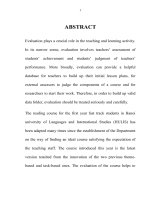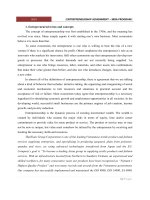Entrepreneurship Assignment for MBA (Dành cho chương trình MBA quốc tế)
Bạn đang xem bản rút gọn của tài liệu. Xem và tải ngay bản đầy đủ của tài liệu tại đây (349.15 KB, 14 trang )
i
MASTER OF BUSINESS ADMINISTRATION
INTERNATIONAL PROGRAM
ASSIGNMENT
ENTREPRENEURSHIP
Submitted to:
Submitted by:
ID No.:
Class:
Ho Chi Minh City, September 2014
ii
Table of Contents
1. Introduction 1
2. Main contents 1
2.1. Are the key entrepreneurial terms and concepts defined and backed by evidence and
sources? 1
2.2. How and what is understood by the statements and words? Is there a discussion and
evaluation in the context of entrepreneurship? 3
2.3. What are the challenges facing entrepreneurs and their organizations in general and
are specific entrepreneurs and their organizations used as examples? What are the
implications for new start-ups within such contexts? 4
2.4. What approaches would you recommend to instill innovation and good organizational
management considering “complexity” and “complicated” and the need for
sustainability in entrepreneurship? 7
2.5. How risks can be mitigated and are those proposals realistic? Were local and foreign
examples used to demonstrate an application of those approaches?
9
3. Conclusion 11
References 11
List of Table
Table 1.1: Definitions of entrepreneurship 2
List of Figures
Figure 1.1: The elements affecting new venture performance 5
Figure 1.2: Risk Management framework 9
1
1. Introduction
Today, there is a new player emerging on the cultural and business scene that does attract of
people concern: the idea of entrepreneur (John Butman, 2013). The idea is that entrepreneur is
those usually a content expert and often an individualist, whose main goal is to influence how
other people think and behave in relation to their valued topic.
The bell about entrepreneurship is everywhere nowadays and becoming a hot issue from
magazine covers to conferences, hotel lobbies and even at the kitchen tables. The
word entrepreneur first appeared in the French dictionary in 1723 described a person who
organizes and operates a business by taking a financial risk. Since then the world has
completely changed bring new arguments for this terms and contexts. There is a risen issue that:
“Entrepreneurs in the 21
st
century face challenges unlike any faced in the past since the
dawn of time. Organizations both new and old operate in vastly changing contexts. Some
argue it has become more complex and others say it is more complicated. Most seem to agree
that complexity in organizations is a lot more difficult to manage than organizations that are
complicated”.
In order to have clearly view about this statement, the author would like to go through each of
aspect as mention in the following contents.
2. Main contents
2.1. Are the key entrepreneurial terms and concepts defined and backed by evidence and
sources?
The word entrepreneur derives from the French word - entreprendre, where “entre” means
“between” and “prendre” means “to take”. Therefore, it was originally used to describe people
who “take on the risk” and “undertake” a task such as starting a new venture. Although no
single definition of entrepreneur exists and no one profile can represent today’s entrepreneur,
research is providing an increasingly sharper focus on the subject.
There are some definitions of entrepreneurship through decades:
Year
Definition
Author
1975
Entrepreneurship is the pursuit of opportunity without regard to resources currently
controlled
Howard
Stevenson
2
1985
Entrepreneurship is an act of innovation that involves endowing existing resources
with new wealth-producing capacity
Drucker
1988
Entrepreneurship is the creation of organizations, the process by which new
organizations come into existence
Gartner
1997
Entrepreneurship is a way of thinking, reasoning, and acting that is opportunity drive,
holistic in approach, and leadership balanced
Timmons
2000
Three traits have been included in the definition of entrepreneurship: (1) Uncertainty
and Risk, (2) Complementary management competence, and (3) Creative opportunism.
Outcalt
[Source: Thierry Burger-Helmchen, 2012]
Table 1.1: Definitions of entrepreneurship
As we can see from the Table 1.1, the academic understanding of entrepreneurship is broadened
over time. The first dimension of the entrepreneurial space is the continuum between economic
approaches oriented towards the origin and context of entrepreneurship, social science
approaches, and managerial concerns. Entrepreneurship is defined as the process by which
individuals pursue opportunities without regard to resources they currently control (led by
Barringer & Ireland, 2010). In essence, an entrepreneur’s behavior finds him or her trying to
identify opportunities and putting useful ideas into practice. In this context, the author would
like to list down an Integrated Definition of entrepreneurship in the twenty-first century:
“Entrepreneurship is a dynamic process of vision, change, and creation. It requires an
application of energy and passion towards the creation and implementation of new ideas and
creative solutions. Essential ingredients include the willingness to take calculated risks- in
terms of time, equity, or career; the ability to formulate an effective venture team; the creative
skill to marshal needed resources; the fundamental skills of building a solid business plan; and,
finally, the vision to recognize opportunity where others see chaos, contradiction, and
confusion” (Kuratko, 2009).
From that point of view, entrepreneurial venture bring new products and services to the market
by creating and then seizing opportunities. The essence of entrepreneurship is creating value –
which refers to worth, importance or utility - and then disseminating that value to customers.
Whatever the specific activity entrepreneurs engage in, they are considered the heroes of free
enterprise in the twenty-first century.
3
In summarize, the concept of entrepreneurship is as the following figure (Mahendra, 2014):
Facebook Inc. is well known a highly successful example of entrepreneurial firm. Having
recognized an opportunity, the entrepreneurs leading companies of this type create products
and services that have worth, that are important to their customers, and that provide a measure
of usefulness to their customers that they would not have otherwise. In Vietnam, VNG is a
successful example of entrepreneurial firm, which based on the new era of information
technology development. VNG Corporation (VNG) is a Vietnamese technology company was
founded in 2004 under the name of VinaGame with specializing in Digital Content and Online
Entertainment, Social Network and E-commerce. From the first contract signed with Kingsoft,
“Vo Lam TruyenKy” became 1st MMORPG online game and the turning point for the online
Entertainment industry in Vietnam. Within 1 month operations, “Vo Lam TruyenKy” game got
a great result 200,000CCU.The owners of VNG have seen the opportunities and take
advantages of human innovation to build the products and services for Vietnamese users such
as Zing Me (a social network) and Zalo (a free massage and call application on mobile).
2.2. How and what is understood by the statements and words? Is there a discussion and
evaluation in the context of entrepreneurship?
As discussed in early, entrepreneurship is a dynamic and risky process. It is an outcome of
complex socio-economic, psychological, technological, legal and other factors. A process of
action an entrepreneur undertakes to establish his/ her enterprise. It is considered a creative
activity, the ability to create and build something from practically nothing. Entrepreneurship is
the attitude of mind to seek opportunities, take calculated risks and derive benefits, by setting
up a venture. Therefore, the process comprises of numerous activities involved in conception,
creation and running an enterprise. Entrepreneurship is about the creation of new business (new
Those who seek to generate value,
through the creation or expansion of
economic activity, by identifying and
exploiting new products, processes or
markets.
is the phenomenon
associated with
entrepreneurial
activity
Entrepreneurial activity: is the enterprising
human action in pursuit of the generation of
value, through the creation or expansion of
economic activity, by identifying and exploiting
new products, processes or markets
4
venture). All new business or increases in self-employment could be considered as creating new
markets if one takes a liberal interpretation of ‘new” for example.
A new venture goes through three specific phases which are prestart-up, start-up and poststart-
up. The prestart-up phase begins with an idea for the venture and ends when the doors are open
for business. The start-up phase commences with the initiation of sales activity and the delivery
of products and services, and ends when the business is firmly established and beyond short-
term threats to survival. The poststart-up phase lasts until the venture is terminated or the
surviving organizational entity is no longer controlled by an entrepreneur.
At last, when references are made to entrepreneurship, it is a relation to the idea that there is
something different about entrepreneurial businesses that sets them apart from other businesses.
For example, policy makers are not interested in merely encouraging the creation of new
business as the be all and end all. Their interest is in creating successful and sustainable entities
with high-growth companies and gazelles. Indeed, the creation of a business environment that
nurtures and stimulates their growth of, and the growth of more productive, companies in
general hence the encouragement of business creation. Some high growth firms’ growth will not
reflect entrepreneurship at all, and indeed, their growth may reflect the very antithesis of
entrepreneurship, for example, firms in monopoly position with rapid growth.
2.3. What are the challenges facing entrepreneurs and their organizations in general and
are specific entrepreneurs and their organizations used as examples? What are the
implications for new start-ups within such contexts?
According to the U.S. Small Business Administration report, there are nearly 600,000 new
business start-ups per year during the past 10 years. In 2011, the smaller firms reached a records
total of 27.5 million (Kuratko, 2009). The motivations for entrepreneurs start new venture
including the need for approval, independence, personal development, welfare considerations,
perception of wealth, tax reduction and indirect benefits, and following role model. However,
the ideas for potential new businesses are also surfacing challenges need to be concerned. It
related to the personal characteristics of entrepreneur, the environment and the venture itself. It
can be indicated as the following figure:
5
[Source: Arnold C. Cooper, “Challenges in Predicting New Firm Performance,” Journal of Business Venturing
(May 1993): 243, led by Kuratko, 2009]
Figure 1.1: The elements affecting new venture performance
The environmental effects are the risk of new products or services, narrow markets and scarce
resources, the entrepreneur’s personal goals and founding process (reasons for start-up), and the
diversity of the ventures themselves (differing scales and potential). In addition to the problems
presented by the complexity of factors in new-venture performance, it is difficult to obtain
reliable data concerning start-up, performance and failure. Also, new-venture developments
deal with established start-up businesses. It requires the full-time commitment of one or more
individuals, is selling a product or service, has formal financial support, and has hired one or
more individuals. Therefore, the real challenges for new venture start-up are for those firms to
survive and growth.
In specific, entrepreneurs also face challenges from numerous sources that include both internal
and external challenges. The followings are some of the most common internal and external
challenges that are facing entrepreneurs nowadays:
Lack of Capital
Most entrepreneurs go into business with inadequate capital with hope to secure more capital
once the business begins to grow. However, most entrepreneurs face capital challenges a few
months after operation. When capital challenges are not addressed in time, most businesses fall
flat on their face. The recommendation for new start-up is sticking to a budget to avoid capital
challenges. Then, starting small and letting a business grow at its own pace also ensures that the
capital generated from doing business can adequately cover all operational expenses and future
expansion plans.
6
Poor management
Poor management may come from poor delegation of duties. Most entrepreneurs starting
businesses tend to delegate crucial duties that should be done only by owners to
others.Therefore, for those new start-ups should be very careful when delegating duties. It is
usually advisable for a business owner to be involved in every aspect of their business when
starting up to avoid management challenges brought about by delegation. Poor time
management is also among the management challenges facing entrepreneurs. Most
entrepreneurs tend to be reluctant in terms of observing the time they get to work or the time
they dedicate to their business. Time management also helps an entrepreneur supervise all
delegated duties. Entrepreneurs who manage time poorly may develop a poor working memory
that may result in an entrepreneur forgetting critical aspects of daily running of a business.
Lack of proper organization:
Most upcoming businesses are facing poor organizational issues, one of which is poor
paperwork storage. Paperwork is very important regardless of the size of a business. If an
entrepreneur cannot be able to organize their paperwork, then they are most likely to misplace
valuable documents such as invoices, customer information that may affect debt collection and
competition strategies among many other vital operations of a successful business.
It is advisable for entrepreneurs to be perfectionists so that employees can learn these skills
from examples. If an entrepreneur is very organized, then his staff is bound to learn
organization and do things the exact way they should be done. An entrepreneur needs to write
down business goals and deadlines for meeting the goals to ensure that focus is generated. It is
possible to stop procrastination by focusing on the goals of a business. It should start with basic
personal experiences in problem solving.
The case failing of Indochina Airlines in Vietnam is a foresee example for this issue. Indochina
Airlines was the first operational private airline based in Vietnam, originally licensed in May
2008 as Air Speed Up. The founder and chairman of the board was Vietnamese musician Ha
Hung Dung. Indochina Airlines began selling tickets on 12/11/2008 and launched its first
commercial flight from Tan Son Nhat International Airport in Ho Chi Minh City to NoiBai
International Airportin Hanoi and Da Nang International Airport in Da Nang on 25/11/2008.
7
After a record of difficulties including unresolved debts and a drop in customers, Indochina
Airlines terminated flying on 25/11/2009. Its schedule was canceled two days later.
2.4. What approaches would you recommend to instill innovation and good organizational
management considering “complexity” and “complicated” and the need for
sustainability in entrepreneurship?
The distinctions between complicated and complex can be illustrated as the following:
- Complicated problems are best dealt with using formulaic and expert-knowledge
approaches. Sending a rocket to the moon is an example of a complicated. The overall
problem can be mechanistically broken down into components parts (booster rocket, cabin
environment, navigational equipment, etc.) and assigned to teams of experts who utilize the
proven methodologies of their disciplines. Meaning that success with one rocket provides
reasonable assurance of success with future rockets. When surprising events do occur, we
can study these, build improvements into the system, and thus raise the probability of future
success.
- Complexity is the degree to which the innovation is perceived as difficult to understand and
use. An example of a complex issue is that of raising a child. Success is raising one child is
no guarantee of success in raising another. Past experience, coupled with advice from
experts, can serve as a starting point; but we know that simply applying the formula that
worked before may not lead to success, and may even lead directly to failure because of the
second child’s resentment at being treated this way.
An innovation need not be particularly complex from the viewpoint of its developers. It is the
perception of the end user that means the most for achieving public adoption of a new
technology. For example, personal computers were difficult to learn about when they first were
introduced, which slowed their adoption despite their clear relative advantages.
In summarize, innovation is the process by which opportunities are identified and exploited.
These opportunities are often radical, and potentially disruptive. The key elements in
developing successful innovation are:
- Creativity that challenges the taken-for-granted assumptions and unsettles the status
quo;
- Entrepreneurial capability that will drive the commercialization the idea;
8
- Management of the process, the staff and other resources, both from within and outside
the organization;
- The motivation and ambition of the individuals to identify and exploit the opportunities.
As an entrepreneur you are someone with the capacity to identify and exploit opportunities.
That is what entrepreneurs do; they have ideas and make them happen. It takes commitment and
perseverance to achieve this. However, it can be very rewarding to contribute by delivering
solutions that create environmental and social value and at the same time do this in a manner
that is self-sustaining from an economic perspective. Sustainable entrepreneurship aims to solve
social and environmental problems by applying business principles. This is accomplished
through providing sustainable business solutions that are characterized according to Oriol et al.,
(2011) are:
- Solutions for one specific social and/or environmental problem
- Clearly defined business models;
- Scalable
- Inspire others to contribute or trigger action among others to develop their own
solutions.
Today, an individual that is empowered with a good idea, determination, and some easily
accessible tools can challenge entire industries. This has led to a new breed of individuals that
use entrepreneurial values and approaches to solve major sustainability problem, we call such
people sustainability entrepreneurs. Sustainability entrepreneurs apply imagination to
challenging problems to conceive, prototype, and create solutions that deliver environmental,
social and economic value. The need for sustainability entrepreneurship comes from three main
reasons:
- There is limited availability of natural resources;
- Exponential human population growth,
- Current and future generations have the right to fulfill their needs.
Example for a good practice for future sustainable energy company for renewable energy name
as synonymous with the entrepreneur is Urban Green Energy (UGE) in USA. Mr. Nick
Blittrswyk found UGE in 2007. It is an international wind turbine supplier and designer of
vertical axis wind turbine. UGE focus on providing high performance, high quality, and
attractive urban energy renewable products to customers around the world at an affordable
9
price. A recent partnership with General Electronic (GE) has put UGE on the map and is now
considered a serious contender in the small wind energy industry. The company has grown fast
and has installations in approximately 60 countries, including with several government
agencies and Fortune 100 companies. Blittrswyk set out to challenge the conventional mentality
and make industry-leading innovations that are raising the standard for renewable companies
all over the world.
2.5. How risks can be mitigated and are those proposals realistic? Were local and foreign
examples used to demonstrate an application of those approaches?
Great entrepreneurs achieve success through deep awareness and management of risks. “Risk
Management” is the art and science of thinking about what could go wrong, and what should be
done to mitigate those risks in a cost-effective manner. In order to identify risks and figure out
how best to mitigate them, we first need a framework for classifying risks.
All risks have two dimensions to them: likelihood of occurrence, and severity of the potential
consequences. These two dimensions form four quadrants, which in turn suggest how we might
attempt to mitigate those risks:
Quadrant A-Cost effectiveness: an important consideration in deciding how we face up to
risks. Risks with relatively minor consequences and a relatively low likelihood of occurring
obviously are not worth spending a lot of time worrying about. For example: getting a flat tire
on your way to a routine meeting. Assuming you service your car regularly and you drive on
maintained roads, a flat tire might cause you to be late to a meeting once every ten years. It's not
a big deal.
[Source: Akira Hirai,
Figure 1.2: Risk Management framework
10
Quadrant B-Nuisance Risks: little things that often seem to go wrong, but whose impacts are
easy enough to minimize through straightforward changes in behavior. Examples: Your lead
engineer gets the flu three days before the scheduled release date of your first customer beta.
Solutions: create a development process free of dependencies on any one person, and build in
contingencies for the fact that almost everything seems to take twice as long and cost twice as
much as you originally expect.
Quadrant C-Insurable Risks that could have major consequences but are relatively unlikely to
happen are often insurable. Insurance is the practice of spreading the cost of an improbable loss
across a group, so that no single individual bears the entire cost of a disaster. Everybody pays a
premium to the insurance company, and the insurance company pays claim benefits when one
of its customers experiences an insured loss. Example: Liability Insurance can mitigate lawsuits
resulting from product defects or on-site injuries to visitors.
Quadrant D-The Company Killers that the risks with both a relatively high likelihood of
occurrence and major consequences. The survival of your venture depends on your ability to
identify and mitigate the company killers. Uncertainty plagues businesses in countless ways, but
we can group most company killers into the following categories:
- Market Risks
- Competitive Risks
- Technology & Operational Risks
- Financial Risks
- People Risks
- Legal & Regulatory Risks
- Systemic Risks
One way for entrepreneurs to mitigate market risk is to avoid perfection. It is a myth to think
that any product will ever be “finished” in the sense that it will make all users completely
happy. When product becomes good enough to make some customers reasonably happy, get it
into the market where it can start generating cash flow and feedback. As Steve Jobs put it,
“Real artists ship”. Release - observe - improve – repeat are the best way that Apple Inc. is
doing successful over its competitors.
11
Practical Risk Management
Creating a pragmatic risk management plan is straightforward in concept, if not in execution.
Suggestion of prepare a table with the following seven columns:
- Risk Factor: List anything we can think of that could cause substantial harm to business.
- Type: Assign the risk to one of the categories described above, e.g. market risk,
competitive risk, technology & operational risk, etc. Assigning a type can suggest who
might be best qualified to manage that particular
- Likelihood: Think of the relative likelihood of manifesting this particular risk factor.
Simple descriptors like high, medium, and low should be sufficient.
- Consequences: Describe what would happen to the company if this risk factor manifests
itself.
- Mitigation Tactics: List the things we can do either reduce the likelihood or minimize the
impact of the consequences if this risk factor manifests itself.
- Mitigation Costs: For each mitigation tactic, think about the implementation cost.
- Status: Once we have assembled the first six columns, we need to decide which
mitigating tactics need to implement depending on our personal risk tolerance. Whatever
actions we do take, we should document them in the Status column of our risk
management plan.
3. Conclusion
Today, entrepreneurship is notable like never before and it is defined in so many ways, such as
social entrepreneurship, intra-entrepreneurship, knowledge entrepreneurship, micro-
entrepreneurship and so on. But whatever the definition of entrepreneurship, it comes to the
idea that entrepreneurs are those who see the opportunities over others and make it come true.
They do not seek power over others and they are not motivated by the vision of achieving great
wealth. Their goal is to make a difference that to make change the world in some certain ways.
They may take the innovation and should be good in risk management at the first phase of start-
up new venture.
In the 21
st
century, take advantage of innovation and development of information technology,
some of them become successful entrepreneurs in many aspects of life. But, for sustainable
12
growth concern will make their business live everlasting. Typically, sustainability entrepreneurs
are on a personal mission to make the world a better place for people around them. For any
reasons of your start-up, play attention to the environment and the community should be the
smart strategy to growth sustainability in today competitive environment. Whatever
complicated or complexity is your organization, it is just a matter of how you run your business
toward the benefits of the community.
References
Akira Hirai. What kills Stratups? Akira Hirai & Cayenne Consulting LLC. Retrieved from
Barringer, B. R. & Ireland, R. D. (2010). Entrepreneurship: Successfully launching new
ventures. Boston, MA: Pearson.
Highqualitywritting.com, (2014). Challenges Facing entrepreneurs. Retrieved from
James Bell &Jelmer, (2012). Sustainable entrepreneurship: The motivation & challenges of
sustainable entrepreneurs in the Renewable energy industry. Retrieved from
John Butman, (2013). Idea Entrepreneur: The New 21
st
Century Carrer. Retrieved from
Kuratko, D. E. (2009). Introduction to entrepreneurship. Australia: South-Western.
Mahendra Shivaji Dhenak, (2014). Concept of Entrepreneur, Entrepreneurship. Retrieved
from
OriolPascual et al., (2011). Create Impact! Handbook for sustainable entrepreneurship.
Retrived from -
centre.org/fileadmin/content/files/6_Resources/1_Publications_pdfs/60_Creating_impact_ful
l.pdf.
Thierry Burger-Helmchen, (2012). Entrepreneurship – gender, Geographies and Social
context. Retrieved from
/>text









